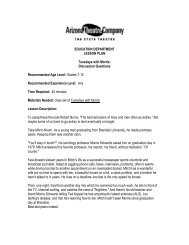Backwards in High Heels Arizona Theatre Company Play Guide
Backwards in High Heels Arizona Theatre Company Play Guide
Backwards in High Heels Arizona Theatre Company Play Guide
Create successful ePaper yourself
Turn your PDF publications into a flip-book with our unique Google optimized e-Paper software.
GLOSSARY<br />
GLOSSARY<br />
Abott and Costello: A famous comedy duo who worked<br />
extensively <strong>in</strong> radio, fi lm and television <strong>in</strong> the 1940s and 1950s.<br />
Their most famous rout<strong>in</strong>e, “Who’s on First” is perhaps the most<br />
well-known comedy rout<strong>in</strong>e of all time and set the bar for all<br />
comedians that followed.<br />
Bette Davis<br />
<strong>Backwards</strong> <strong>in</strong> <strong>High</strong> <strong>Heels</strong><br />
Comedy duo Abbott & Costello<br />
Bette Davis: An actress well-known for her <strong>in</strong>tense portrayal<br />
of dramatic roles (and her forceful nature both on and offscreen)<br />
made Bette Davis one of the most iconic fi lm stars<br />
of her day. Though G<strong>in</strong>ger Rogers and Bette Davis had very<br />
different onscreen personas for many years, they were good<br />
friends.<br />
Busby Berkeley: A highly <strong>in</strong>fl uential Hollywood movie<br />
director and musical choreographer, Berkeley’s musical<br />
numbers are still some of the most famous screen moments<br />
of all time. He was known for us<strong>in</strong>g shots that looked down<br />
from above on his dancers while they created complex<br />
geometric patterns with their bodies.<br />
Ethel Merman: An actress and s<strong>in</strong>ger who dazzled both<br />
Busby Berkeley<br />
stage and screen with her powerful voice and persona. She<br />
appeared <strong>in</strong> Girl Crazy alongside G<strong>in</strong>ger Rogers <strong>in</strong> 1930,<br />
as well as <strong>in</strong> I Got Rhythm <strong>in</strong> 1930, Anyth<strong>in</strong>g Goes <strong>in</strong> 1936, and There’s No Bus<strong>in</strong>ess Like<br />
Show Bus<strong>in</strong>ess <strong>in</strong> 1954. A star of both the stage and the screen, she has been called "the<br />
undisputed First Lady of the musical comedy stage."<br />
Feathers: A nickname that Fred Astaire used for G<strong>in</strong>ger. It came about on the set of Top Hat,<br />
perhaps their most famous fi lm, made <strong>in</strong> 1935. For the pr<strong>in</strong>cipal number “Cheek to Cheek,”<br />
G<strong>in</strong>ger <strong>in</strong>sisted on wear<strong>in</strong>g a lavish ostrich feather dress. While the dress moved well, it<br />
would scatter feathers when she danced - all across the fl oor, <strong>in</strong> front of the cameras, and <strong>in</strong><br />
Fred’s hair and clothes. Fred Astaire and Hermes Pan jok<strong>in</strong>gly rewrote the lyrics to “Cheek to<br />
Cheek” to say “Feathers, I see feathers…” In the end, Fred apologized to G<strong>in</strong>ger with a gold<br />
feather charm and a note read<strong>in</strong>g “You were right.”<br />
<strong>Arizona</strong> <strong>Theatre</strong> <strong>Company</strong> <strong>Play</strong> <strong>Guide</strong> 19



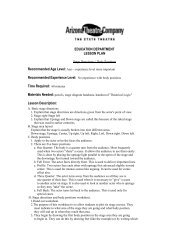



![Play Guide [356k PDF] - Arizona Theatre Company](https://img.yumpu.com/46218320/1/190x245/play-guide-356k-pdf-arizona-theatre-company.jpg?quality=85)
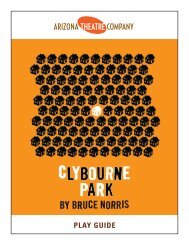
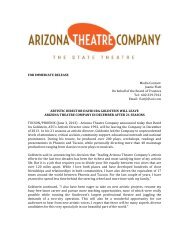
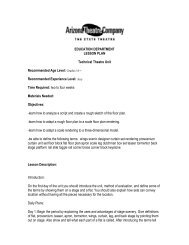
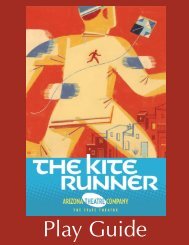
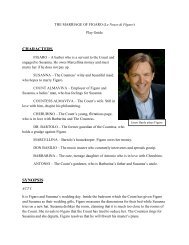
![[title of show] Arizona Theatre Company Play Guide 1](https://img.yumpu.com/24482689/1/190x245/title-of-show-arizona-theatre-company-play-guide-1.jpg?quality=85)
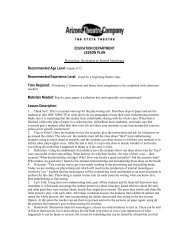
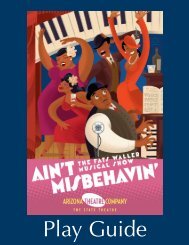
![Play Guide [1.2MB PDF] - Arizona Theatre Company](https://img.yumpu.com/11952176/1/190x245/play-guide-12mb-pdf-arizona-theatre-company.jpg?quality=85)
